- EYEWITNESS REPORT
- by Sebastian Pammer
- PHOTOS BY SEBASTIAN PAMMER
From the internet site www.tautos-balsas.lt I learned that the march of Lithuanian nationalists would start today at 4 PM (1600 hours) at Cathedral Square in the very heart of Vilnius, where the city’s central boulevard, Gedimino Prospect, begins its ascent toward the nation’s Parliament at its other end.

Kazimieras Uoka, at right, a member of the Lithuanian parliament from the Conservative party in power, was one of the leaders of the massive neo-Nazi march on the capital’s main boulevard on the country’s Independence Day.
I was shocked to see that one of the march’s leaders was a member of parliament from the ruling Homeland Union faction of the Conservative alliance in power (whose prominent Jewish member actually signed the Prague Declaration in 2008!). MP Kazimieras Uoka was marching at the very front. In 2010 Uoka’s pro-neo-Nazi activities were in evidence more than once. He had taken out the permit for last year’s Nazi march (Leonidas Donskis’s comment on that here) and then in May, he jumped the barricades to disrupt the wholly peaceful Gay Pride parade in Vilnius.
Once again, the neo-Nazi march in the center of a European Union member capital was held legally, with a full permit issued by the city municipality, and with no public protest from leading political figures, the Foreign Ministry or any of the state-sponsored ‘Jewish Studies’ units on which so much state treasure is spent (see e.g. a report on the recent London conference).
Before the march got underway, a brass orchestra chimed out joyous marching music and well known tunes that boomed across Cathedral Square. Behind the podium, where the orchestra was playing, a group of young people in military outfits and leather jackets was organizing itself. All of them were wearing armbands with the Lithuanian national colors and many carried Lithuanian flags.
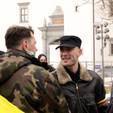 Among the participants were Ricardas Cekutis, current head of PR at the state-sponsored Genocide Research Center with (at the right) Mindaugas Murza, the infamous neo-Nazi (this photo courtesy of Adomas Jablonskis). The group grew larger and larger, reaching around a thousand, and it was not long until a group of about 50 policemen made their way over the square to take up their positions around the crowd. At that point many older and middle-aged people, without distinctive clothing joined the group. They were all wearing a Lithuanian armband and there was a dazzling number of Lithuanian flags.
Among the participants were Ricardas Cekutis, current head of PR at the state-sponsored Genocide Research Center with (at the right) Mindaugas Murza, the infamous neo-Nazi (this photo courtesy of Adomas Jablonskis). The group grew larger and larger, reaching around a thousand, and it was not long until a group of about 50 policemen made their way over the square to take up their positions around the crowd. At that point many older and middle-aged people, without distinctive clothing joined the group. They were all wearing a Lithuanian armband and there was a dazzling number of Lithuanian flags.
Among them were flags with swastikas and SS insignia (such as the flag of the ‘Lithuanian Skinheads’) as well as black, white, and red flags. Many people wore badges with swastikas sewed onto their clothing. Some were wearing white armbands with flames (that essentially resemble a swastika, a symbol that was also on some of the flags). Some of the protesters had a swastika with ‘diktatura’ written above it on their clothing. The badge of the ‘Skinheads Vilnius’ could be seen on many sleeves.
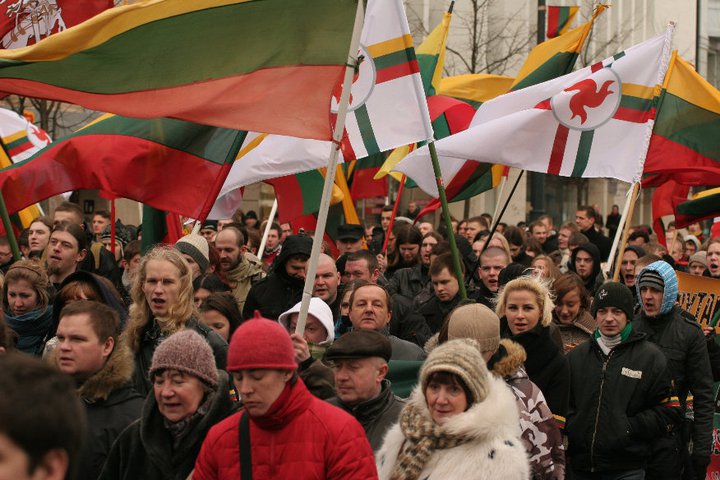
Many of the swastikas brandished took the shape of the ‘Lithuanian swastika’ (with extra lines presumed to indicate ‘the Pillars of Gediminas’, an unfortunate abuse of the legacy of the fourteenth century grand duke who helped make the Grand Duchy of Lithuania into a symbol of multicultural and multiethnic tolerance).
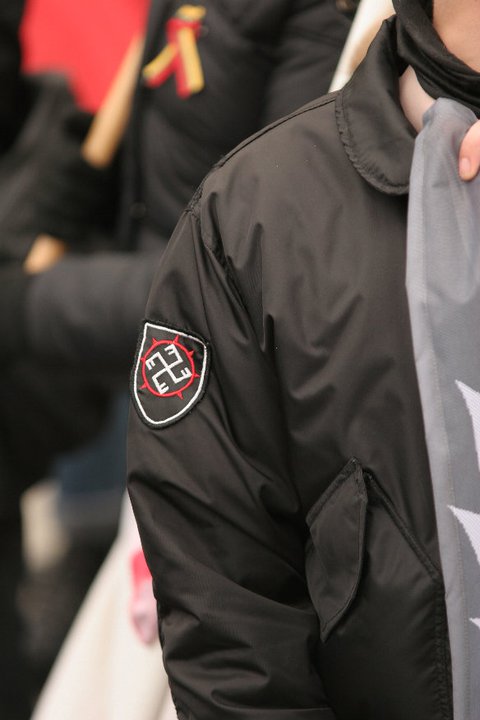
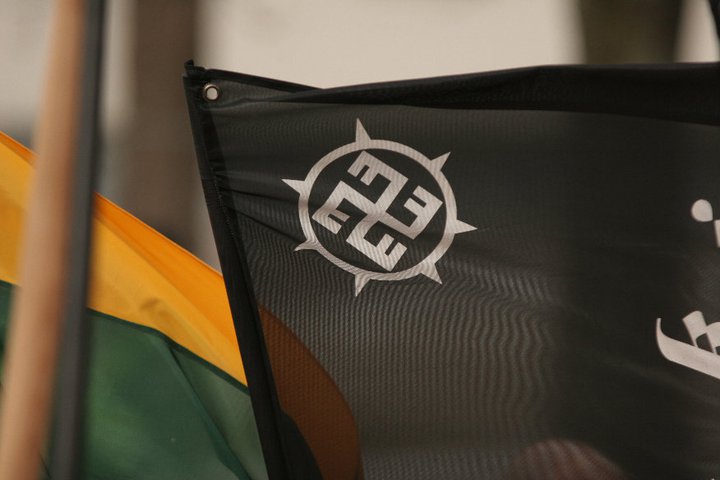
Last May, a Lithuanian court ruled that public displays of swastikas are legal in the country, on the grounds that the swastika is an ancient symbol of Baltic nationhood rather than a Nazi symbol (see DefendingHistory.com reports here and here). Less then two years earlier, the country’s parliament had banned both Nazi and Soviet symbols (report here), equally, but now the swastika is exempted from that ban.
Darius Ross on Twitter has a question for the president and the prime minister
UPDATE: After Western embassies intervened, the PM issued a weak statement three days later (14 March)
At the very front was a huge banner of the ‘Skinheads’ as well as a banner with national symbols (pictures of Trakai castle, Gediminas’s Tower, Lithuanian resistance fighters, poets and more). One banner just had the date December 17, 1926 on it, the day of the Smetona coup d’état, when the interwar Republic of Lithuania had in some respects abandoned its democracy.
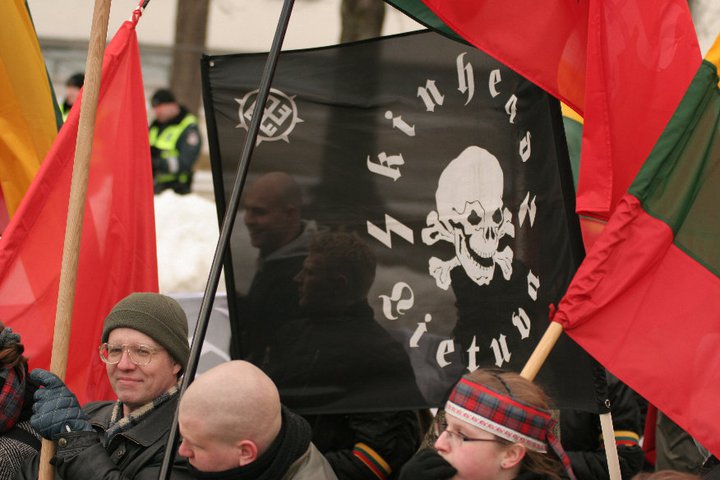
One banner was in Lithuanian and German calling for the freedom of peoples. Another just said: ‘Today in the street, tomorrow in parliament’. There were many other banners.
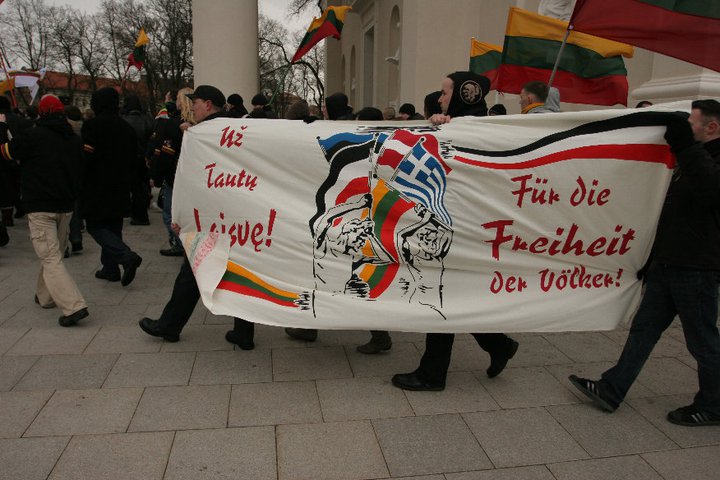
At about 10 past 4, the march started up, and at that point the number of participants was between 500 and 1000. Over the Cathedral Square the crowd was working its way toward Gedimino Prospect, aggressively chanting ‘Lietuva, Lietuva’. On Gedemino Prospect I saw the police arresting two persons, but it was not clear why or what if anything had occurred on the spot.
Former member of parliament Gediminas Jakavonis was proud to join the neo-Nazi marchers
I saw a group of five young Lithuanians who formed a counter demonstration at Savivaldybes Square. They were carrying Lithuanian flags, EU flags, one rainbow flag and held up placards demanding a more tolerant and less racist Lithuania. They were wearing raincoats with badges of the Yellow Jewish Ghetto star, and of the concentration camp insignia of Gays and Roma, showing their sympathy for the minorities of Lithuania.
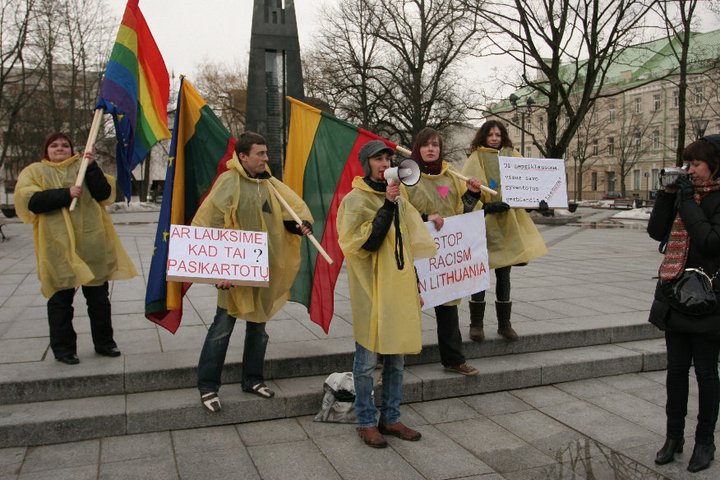
After the thousand-strong march passed this tiny five-person protest they continued to march their way up Gedimino Boulevard.
The march kept going up Gedimino Boulevard, chanting aggressive Lithuanian slogans. At one point some of the protesters started to sing the Horst-Wessel song. When the demonstration reached Lukiskes Square they all gathered in front of the Museum of Genocide Victims at the memorial to Lithuanian freedom fighters.
At the Genocide Museum, speeches were given by one of the organizers of the demonstration and an imported representative of a German neo-Nazi group who spoke in German. He complained about the lack of freedom of speech in Germany and he admired this protest in Lithuania. At the end of the speeches some of the protestors gave Heil Hitler salutes. After the Lithuanian national anthem was sung the crowd started to disperse.
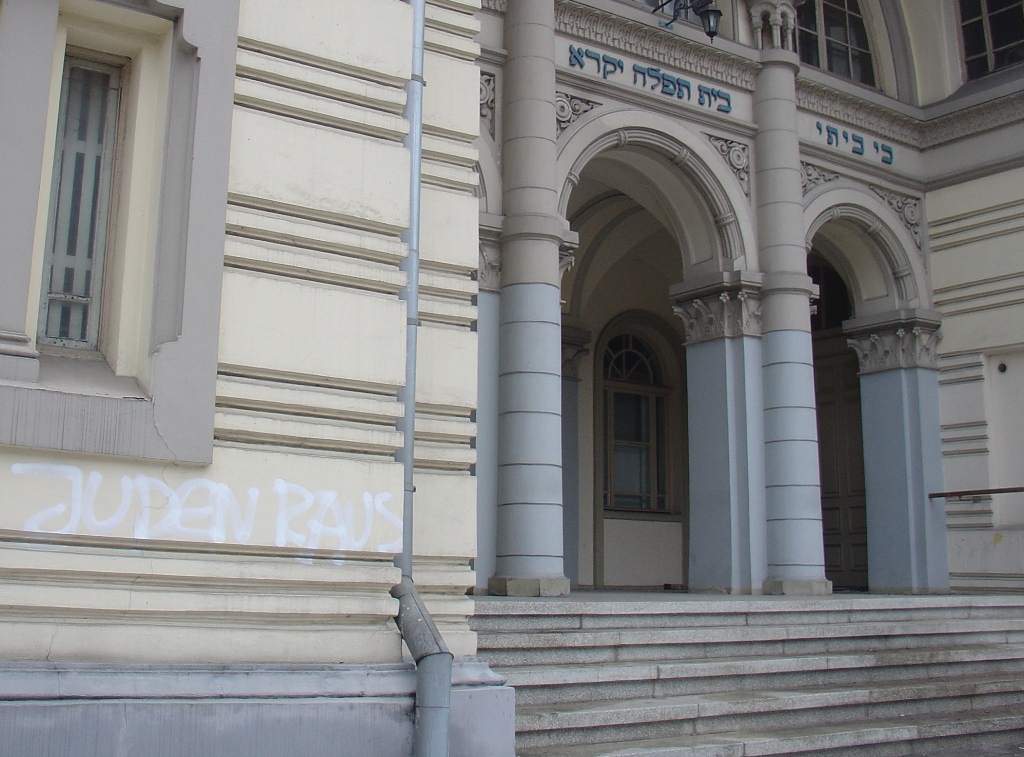
Sometime during the country’s independence day, Vilnius’s only functioning pre-war synagogue was defaced with the words ‘Juden raus’.
Sebastian Pammer is the Gedenkdiener volunteer at the Green House in Vilnius for 2010-2011. More of his images of the 11 March 2011 neo-Nazi parade appear on his Facebook page.